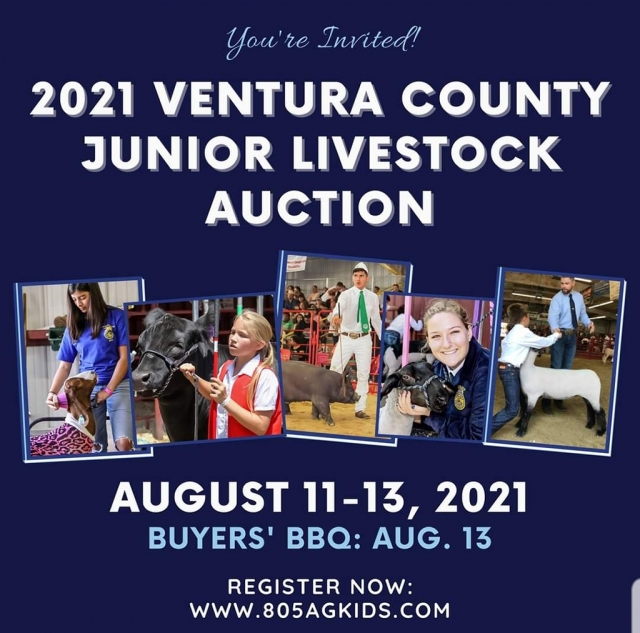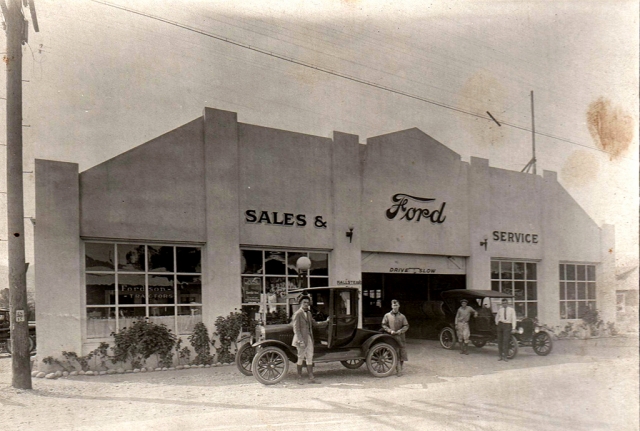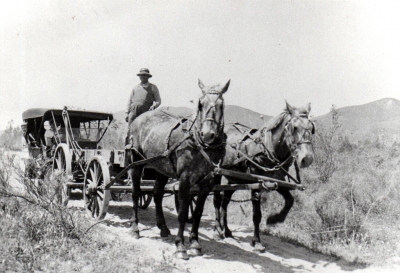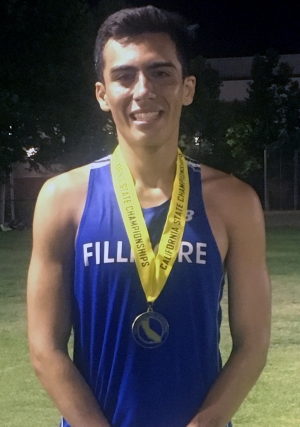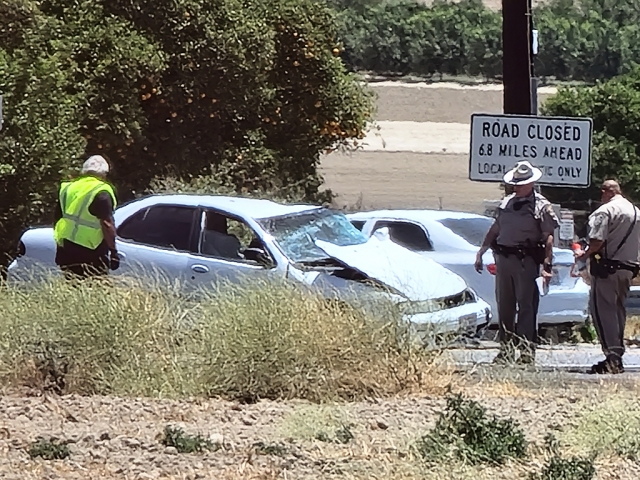|
By Anonymous — Wednesday, July 7th, 2021
Buyer registration is now open for the 2021 Ventura County Junior Livestock Online Auction happening August 11-13, 2021. Register at: https://bit.ly/3q8jeEx The Ventura County Fair has been cancelled for the second year in a row. Our local Ag Kids need your support now more than ever. Join us for the 2021 Ventura County Junior Livestock Online Auction to ensure the 146-year tradition of buying our local 4-H, FFA, Grange & Independent Ag Kids' livestock projects continues. Auction Details: Register now for free BBQ tickets & details: https://bit.ly/3q8jeEx Learn more about this year's Auction in our Buyer's Guide, available at: https://bit.ly/378QMuM Thank you for your support of our local Ag kids! The Ventura County Fair has been cancelled for the second year in a row, however the Junior Livestock show will go on virtually this year. For more details visit www.805AgKids.com |
 Dr. Adrian Ong and Dr. Linnea Fechtner. Linnea has been selected to pursue an Otology Fellowship in Sarasota, Florida as a Cochlear Implant surgeon. Linnea graduated from Case Western Reserve University School of Medicine in Cleveland, Ohio, Class of 2016. Dr. Ong graduated from the Jacobs School of Medicine & Biomedical Sciences at The University of Buffalo in 2015 and will pursue a Facial Plastic & Reconstructive Surgery Fellowship in Fort Worth, Texas. Enlarge Photo By Anonymous — Wednesday, July 7th, 2021
Congratulations to Fillmoreâs Dr. Linnea Fechtner on the completion of her 5th year Otolaryngology chief residency in Buffalo, New York, 2016-2021. Linnea will now pursue an Otology Fellowship in Florida as a Cochlear Implant surgeon. There are two residents selected each year for this difficult surgical specialty. A cochlear implant is a small electronic device that electrically stimulates the cochlear nerve (nerve for hearing). The implant has external and internal parts. The external part sits behind the ear. The internal part is placed under the skin behind the ear during an outpatient surgery. An otolaryngologist-head and neck surgeon provides comprehensive medical and surgical care for patients with diseases and disorders that affect the ears, nose, throat, the respiratory and upper alimentary systems and related structures of the head and neck. Head and neck oncology, facial plastic and reconstructive surgery and the treatment of disorders of hearing and voice are fundamental areas of expertise. Linnea, daughter of Michael and Diane Fechtner, was raised in Fillmore on the âFechtner Farmâ, surrounded by avocado and orange orchards. She attended St. Bonaventure High School, graduating as 2008 Valedictorian, before going on to graduate from the University of Notre Dame, and the Case Western Reserve University School of Medicine in Cleveland, Ohio, Class of 2016, where she earned Honors with Distinction. Understandably, Linneaâs family is incredibly proud of her accomplishments and for choosing a career which will have an impact on the lives of so many: parents Michael and Diane, grandparents Mercy and Lupe Ramirez and Howard and Linda Fechtner; sister Sigourney and husband Andrew, and nephew and niece, Jackson and Miriam Castel de Oro. I Peter 4:10 â âGodâs gifts of grace come in many forms. Each of you has received a gift in order to serve others. You should use it faithfully.â |
|
By Anonymous — Wednesday, July 7th, 2021
[Courtesy Fillmore History Museum] Excerpts from âHorseless Carriages Come To Ventura Countyâ by Edith Moore Jarrett in Old Timersâ Tales of Fillmore. Edith was a Fillmore native and founder of the Fillmore Historical Museum. In March 1916, Fillmoreâs weekly newspaper proudly proclaimed, â1510 AUTOS OWNED IN VENTURA COUNTY!" Ernie Smith, like all young fellows, could tell you the make of anything on wheels, so after he read that item one Sunday afternoon, he went out to the road by his home east of town, sat down under a tree, and tallied every auto that passed. A total of 134 when by in 4 hours, and guess which model scored the highest. Yes, the Model T âTin Lizzieâ with 46. See if you can remember (2021 - or every heard of) the other models he saw that day. There were 18 Dodges, 10 Maxwells, 9 Buicks, 8 Studebakers (the company had retooled from buggies to cars; remember the âE M Fâ â Every Morning Fixit?), 6 Cadillacs, 6 Chalmers, 4 Overlands, 4 Hupmobiles, 3 Reos, 3 Chandlers, and 2 Regals. Those who got honorable mention for one each were Grant, Lexington, Locomobile, Paige, Winton, and Apperson (the âJackrabbit,â remember?). By 1915, John Deere had moved his plows and cultivators over, to manufacture the âBilt-Well Sixâ in four models: A 2-passenger roadster âwith mohair top,â A 4-passenger âChummy Roadster,â A 5-passenger touring car at $1295, and a seven-passenger model at $1800. George young sold them, with headquarters at the Elkins Ford garage. He also sold Maxwell roadsters âwith one man topâ for $655 that he said got 21.8 miles per gallon, and five passenger models for $725. But he sold Dr. William Manning a valley âBilt-Well sixâ roadster for his house calls. in 1912, Harvey Smith was selling Paiges and Hudson's, advertising that âall have self-starters.â the Mooreâs Rio didn't. We bought it from a fellow who sold it just to get the 1913 model with self-starter. He was smart. We cranked that big thing, a quarter turn at a time, for nine years before we got a Chevrolet with a starter. Of course, my folks had to get drivers licenses. I was only 14, so didn't think I was old enough to need one. I just drove and no questions asked. The license was printed on an eight by eleven sheet of paper which stated that the applicant was certified as a driver for life. Mama showed hers to the CHP just for fun when she was eighty-seven and still driving and threw the whole office into a tizzy. Of course, she had had the new kind all along, too. We didn't push a button to turn on the lights of that 1912 Rio. There was a brassy looking tank of Prestolite, a fuel sort of like propane, on the running board, and we turned in the whole thing when we needed a refill. Turning on the headlights was a family affair, and we all got out of the car to watch. First, the kid elected to stand by the lamps had to unscrew the latches of the brass-bound doors of the headlights, swing them open on their hinges, and hold a lighted match ready. Then the kid stationed at the running board with a wrench - after he found it in the toolbox - was supposed to give the valve on the Prestolite tank a slight turn. Since it always stuck, heâd turn it on too much, and if it didn't blow out the match, the gas would flare up and singe the match holder. âTurn it down!â we'd all yell, the wrench operator would jerk it clear off instead, and they'd have to start over. Usually, it took several matches before they got synchronized. When Papa said, âWe'd better start home now. Have to milk cow before dark,â we knew he was really thinking about getting there before we had to turn on those little lights. It took a little while for people, to get used to cars. Several have told us how Judge Elkins started proudly down Central in his new 1912 Model T, forgot how to stop it, and rolled along yelling frantically, âWhoa! Whoa!â. Somebody should have told him, âJust step on any two pedals.â Later on, John Opsahl sold the Judge a Dodge with four on the floor, but he still had a problem. When he took the family to Santa Paula, they all dreaded that short climb up Atmore Hill, just west of the present Rancho Sespe bunkhouse. It was pretty steep until the road was cut down in 1916 to be paved. Few cars could make it up in high gear. The judge solved that one. Heâd stop at the foot of the little grade, order family out to push if necessary and drive up in low. He didn't find out for some time that he could shift those gears back from high to second or low while he climbed. There was another hill that no sane driver would ever think of trying to climb with a car. That is, no one but John Opsahl, our first wheeler dealer. The Big Hill started up the Little Sespe to the oilfields from the boardinghouse at the foot where teamsters could get extra horses and a lunch before they started up that 34 % grade dirt road. But in 1916, John made it with his Dodge demonstrator and showed off âsome whirligigs at the crest,â as the Herald put it. After that he advertised, âDodge, the Car That Climbs the Big Hill Any Time.â John could have sold sand to the Sahara. Two Elkins brothers, Carl, Jr., and Reed had the Ford garage and advertised âenough Ford parts to assemble a complete car.â And you know what John did? He sold Judge Elkins and sons Carl, Jr., Bill, and Hess, each a Dodge the same week. Only Reed could resist the fast talker. John was always showing off in his Dodge demonstrator. Beyond the Sanitary Dairy, the old road had two unbanked right-angled corners on property boundaries. One corner had a water tank for the sprinkling wagon. John bet some fellows he could make both corners at 60 miles an hour, and, collecting a gallery of witnesses, away he went. Well, the Doge got around the first corner but took with it just one leg of that water tank tower. John lost his bet, but at least he got a free shower. Two young men-about-town. Joel Schwartz and Hub McCampbell, heard about it and decided to give their dates a scare. One evening Hub aimed his Maxwell right at the leg of another water tank, planning to swerve at the last second to miss it. He did. But the rear end of the car swung around, hit that leg, and down came the whole tank just behind them. The girls werenât the only ones scared. Well, the hitching racks have disappeared. Model Ts and a lot of other models are collectorsâ items, and these days we just move our housework into a self-contained RV and think weâre on vacation. âHorseless carriages killed Buckhorn, which was about to become a town,â Harry Felsenthal said, âbecause people could get to Fillmore with their cars.â Horseless carriages brought the oil workersâ families down from Torrey Hill and eventually put the Southern Pacificâs passenger trains and a lot of freight cars out of business. Horses and cars have switched places as a status symbol. If you can support a horse or two, youâre landed gentry. As J. P. Morgan said about yachts, âIf you have to ask about the upkeep, you canât afford one.â But there probably more horses loafing around the county now that the 1,510 autos the Herald bragged about in 1916. |
|
By Anonymous — Wednesday, July 7th, 2021
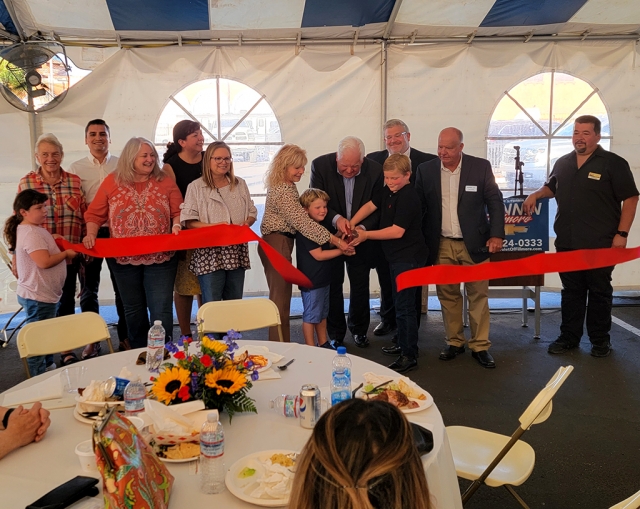 The long awaited Grand Opening for the new Fillmore Bunnin Chevrolet dealership was well attended. An enthusiastic crowd packed the main tent where everyone enjoyed many food choices while listening to live music. Congratulations to Mr. Bunnin and his right-hand-man, Shane Morger, who created the whole event; and a hearty Welcome to Fillmore! Enlarge Photo |
|
By Anonymous — Wednesday, June 30th, 2021
A 16-year old Fillmore juvenile male student was arrested after making a threat of having a bomb while on school grounds at Fillmore High School. On 06/29/2021, at approximately 11:11 a.m., patrol deputies responded to Fillmore High School in reference to a bomb threat report. Prior to arrival, it was learned that a known male juvenile used an online communication service and stated that he âhad a bomb in his backpack.â With the assistance of staff from the Fillmore Unified School District, students were safely evacuated from the premises and the juvenile was subsequently arrested. The area of concern was searched by investigators from the Fillmore Police Department and the Ventura County Sheriffâs Office Bomb/Arson Unit. The school and surrounding area was deemed safe and no explosive devices were located. The juvenile was booked into custody at the Juvenile Justice Center in Oxnard for violations of making Criminal Threats and a False Report of a Bomb. The juvenile remains in custody with a court date set for July 1, 2021. The identification and apprehension of this individual would not have been possible without alert school officials and the cooperative relationship between the Fillmore Police Department and the Fillmore Unified School District. Nature of Incident: Bomb Threat Ventura County Crime Stoppers will pay up to $1,000 reward for information, which leads to the arrest and criminal complaint against the person(s) responsible for this crime. The caller may remain anonymous. The call is not recorded. Call Crime Stoppers at 800-222-TIPS (8477). |
|
By Anonymous — Wednesday, June 30th, 2021
There will be no Sespe Creek Car Show or Chili Cook-Off in Fillmore on 4th of July. The City of Fillmore will be hosting a fireworks show on Saturday, July 3rd at the Fillmore Middle School baseball fieldâit is expected to begin at 9pm. Courtesy City of Fillmore. |
|
By Anonymous — Wednesday, June 30th, 2021
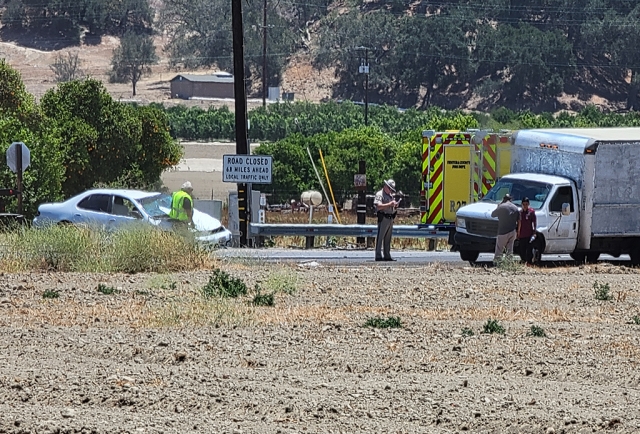 On Friday, June 25th at 12:18pm, Sheriffs and Firefighters responded to a collision on Charmberburg and Guiberson Road in Bardsdale. A white sedan and a white truck collided, causing damage to both vehicles. No further details were given at the time of the accident. Enlarge Photo |
|
By Anonymous — Wednesday, June 30th, 2021
The Ventura County Sheriffâs Office of Emergency Services is in the process of updating the Ventura County Hazard Mitigation Plan (HMP). The plan update is a multi-jurisdictional effort involving over 20 different partners, including all 10 of the Countyâs incorporated cities, the Countyâs Watershed Protection District, the Ventura County Office of Education, and the County Fire Protection District. The HMP strives to inventory the natural hazards that Ventura County is most vulnerable to, assess risks to the Countyâs community members, buildings and critical facilities, and develop a mitigation strategy to reduce the risk of exposure and allow a swift, equitable, and organized recovery should a disaster occur. The Countyâs most recent HMP was adopted in 2016, but requires updating every five years to maintain federal funding eligibility. The public is invited to learn more about the HMP and opportunities for participation in the update process by visiting www.ReadyVenturaCounty.org. Nature of Incident: Ventura County Hazard Mitigation Plan Update |

